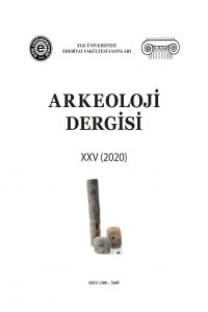Isparta Müzesi’nden Bir Grup Çark Yapımı Kandil: Demlik Forms
Önemli bir kent müzesi olarak hizmet vermekte olan Isparta Müzesi gerek nicelik gerekse niteliksel olarak zengin bir kandil koleksiyonuna sahiptir. Bu eserler arasında yer alan ve Demlik Form olarak tanınan özel bir grup bu çalışmada irdelenecektir. Yayında 16 örneğe yer verilmiştir. Bu kandiller satın alma yöntemiyle müzeye kazandırılmışlardır. Bu nedenle eserlerin buluntu yerleri tartışmalıdır. Eserler iki alt tip şeklinde sınıflandırılmış ve kronolojik olarak tanıtılmıştır. Çalışma da yer verilen bu grup örnekleri henüz yeterince tanınmamaktadırlar. Son dönem bazı çalışmalarda örnekleri gözlenmeye başlamıştır. Bu kandiller çark yapımıdırlar ve demlik formunda bir gövdeye sahiptirler. Üzerlerinde astar dışında herhangi bir süsleme öğesi gözlenmez. Astar, daldırma yöntemiyle uygulanır. Burun yapıları kısa veya uzun olabilir. Gövde üzerinde genellikle küçük-alçak tutamaklar gözlenir. Bununla birlikte kulplu örneklerde bulunmaktadır. Bazı örnekler üzerinde kazıma yazı/rakamlar tespit edilmiştir. Literatür verileri doğrultusunda bu kandillerin 2.- 4. yüzyıllar arasında kullanıldıkları anlaşılmıştır. Üretim merkezlerinin Anadolu ve özellikle Pisidia Bölgesi olduğu düşünülür. Bu noktada da kazı yayınlarından hareketle Sagalassos ve Kibyra’nın öne çıktığı görülür .
A GROUP OF WHEELMADE LAMP AT THE MUSEUM OF ISPARTA: TEA POT TYPE
Isparta Museum, which serves as an important regional museum of archaeology, has both a quantitative and qualitatively rich oil lamp collection. A special group, known as the Tea pot type, of which 16 examples are kept at the museum will be discussed in this study. These lamps were bought by the museum and therefore, their find places of the artifacts are unknown. The objects are classified into two subtypes and presented chronologically. These subtypes are not well known yet. Examples of the type have appeared in some recent studies. These oil lamps are wheel-made and have a body in the type of teapot. No decoration can be seen on them except for the slip. The slip is applied using the dipping method. Their noozles can be short or long. Small and low lugs are usually observed on the body, but handles are also present. There are grafitti (perhaps numerals) on some examples. According to literature, these lamps were used between the 2nd and 4th centuries AD. Production centers are considered to be located in Anatolia and more especially in the ancient region of Pisidia. At this point, based on current studies, Sagalassos and Kibyra are the most likely places of productıon.
___
- Atasoy 2005: S, Atasoy, Halûk Perk Koleksiyonu’ndan Bronz Kandiller. Tuliya I, İstanbul, 193-229.
- Aydın Tavukçu ve Gülünay 2018: Aydın Tavukçu, E. Z. Gülünay, “Afyonkarahisar Arkeoloji Müzesi’nden Bir Grup Demlik Formlu Kandil”. Atatürk Üniversitesi Sosyal Bilimler Enstitüsü Dergisi, Aralık 2018, S. 22 (Özel Sayı), 2731-2743.
- Bailey 1972: D.M. Bailey, Greek and Roman Pottery Lamps, Oxford.
- Bailey 1975: D.M. Bailey, Catalogue of the Lamps in the British Museum I. Greek, Hellenistic and Early Roman Pottery Lamps, London.
- Bailey 1988: D.M. Bailey, Catalogue of the Lamps in the British Museum III. Roman Provincial Lamps, London.
- Bailey 1992: D.M. Bailey, “Thysdrus, the Troad, Sagalassos and Gortyn”. Zeitschrift für Papyrologie und Epigraphik, 92, 280.
- Başer 1990: S. S. Başer, “1988-89 yılları Kibyra Kurtarma Kazıları”. I. Müze Kurtarma Kazıları Semineri, Ankara, 235-260.
- Bussière ve Lindros Whol 2017. J. Bussière, B. Lindros Whol. Ancient Lamps in the J. Paul Getty Museum. Los Angeles: The J. Paul Getty Museum.
- Coşkun 2007: D. Coşkun. Konya-Ereğli Müzesi’nde Bulunan Roma Dönemi Kandilleri. (yayınlanmamış yüksek lisans tezi), Konya: T.C. Selçuk Üniversitesi Sosyal Bilimler Enstitüsü Arkeoloji ABD. Klasik Arkeoloji Bilim Dalı.
- Çokay 1998: S. Çokay. Antik Çağda Aydınlatma Araçları, İstanbul.
- Ronald ve Waelkens 1993. D. Roland ve M. Waelkens, “The Common Ware”. M. Waelkens (ed.), Sagalassos I, First General Report on the Survey (1986-1989) and Excavations (1990-1991), Leuven: 131-152.
- Fırat ve Metin 2011: M. Fırat, H. Metin, Isparta Müzesi’nde Yer alan Bir Grup Kandil. ADerg 24, 143-154.
- Fırat ve Metin 2 016: M . Fırat, H. Metin, A Vaulted Tomb in Isparta/Çünür and Its Finds. ADerg 21, 128-140.
- Poblome ve Waelkens 1993. J. Poblome, R. Degeest, M. Waelkens, E. Scheltens. “The Fine Ware”. M. Waelkens (ed.), Sagalassos I, First General Report on the Survey (1986-1989) and Excavations (1990- 1991), Leuven: 113-130.
- Poblome ve Waelkens 2003: J. Poblome, M. Waelkens, “Sagalassos and Alexandria, Exchange in the Eastern Mediterranean. Les ceramiques en Anatolie aux epoques hellenistique et romaine, ed. C. Abadie- Reynal”,. Varia Anatolica, 15. Paris: 179-191.
- Heimberg 1973: U. Heimberg, “Lampen”. Antiken aus Rheinischem Privatbesitz, 116-137, Köln.
- Laflı 2015. E. Lafı, “Terracotta Lamps from Seleceia Sidera in Pisidia (southwestern Turkey)”. E. Laflı, S. Patacı (eds.), Recent Studies on the Archaeology of Anatolia, British Archaeological Reports, International Series 2750, Oxford: 231-242.
- Metin 2012: H. Metin, Kibyra Kandilleri. (Yayımlanmamış Doktora Tezi), Erzurum: Atatürk Üniversitesi Sosyal Bilimler Enstitüsü.
- Oziol vd. 1969. T.Oziol, J. Thérèse J. Pouilloux, Les Lampes, Salamine de Chypre I, Paris.
- Öz 2014: C. Öz, Silifke Müzesi’nde Bulunan Pişmiş Toprak Kandiller. (yayınlanmamış yüksek lisans tezi), Konya: T.C. Selçuk Üniversitesi Sosyal Bilimler Enstitüsü Arkeoloji ABD. Klasik Arkeoloji Bilim Dalı.
- Roovers 1993: I. Roovers, “The Lamps”. M. Waelkens (ed.), Sagalassos I, First General Report on the Survey (1986-1989) and Excavations (1990-1991), Leuven: 153-162.
- Scheltens 1993: E. Scheltens, “Some Wheelmade Lamps of Sagalassos. A Preliminary Note”. M. Waelkens, J. Poblome (eds.), Sagalassos II, Report on the Third Excavation Campaign of 1992, 191- 208, Leuven: 191-207.
- Talloen 2001, P. Talloen, The Egyptian Connection, The Cult of Nilotic Deities at Sagalassos. Ancient Society, 31, 289-327.
- Tekocak 2013: M. Tekocak, “Akşehir Müzesi’nde Bulunan Pişmiş Toprak Kandiller”. K. Levent Zoroğlu’na Armağan, Studies in Honour of K. Levent Zoroğlu. İstanbul: 707-728.
- ISSN: 1300-5685
- Yayın Aralığı: Yılda 2 Sayı
- Başlangıç: 1991
- Yayıncı: Ege Yayınları
Sayıdaki Diğer Makaleler
Giresun Müzesi’nde Bir Grup Pişmiş Toprak Unguentarium
Son Buluntularla Erken Tip Klazomenai Lahitlerine Yeni Bir Bakış
Isparta Müzesi’nden Bir Grup Çark Yapımı Kandil: Demlik Forms
Kıyı Batı Anadolu’nun Kronolojisi ve Terminolojisinin Yeniden Değerlendirilmesi
Yusuf ÇiFTÇi, Ergül KODAŞ, Charlotte LABEDAN-KODAŞ, Kazım ÖZKAN
